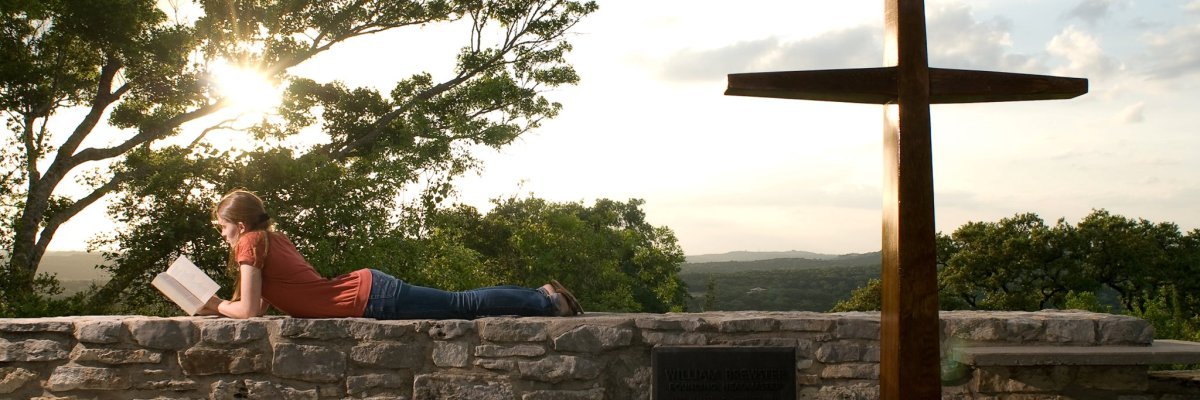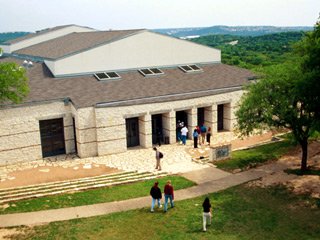
Facilities
St. Stephen's School
St. Stephen’s students tend to be adventuresome and individualistic. This independent thinking makes the college counseling process at St. Stephen’s an exciting journey for all involved. Learn all about St. Stephen’s School here, or read the brief history below.
Celebrating six decades of service, St. Stephen’s builds on tradition for the 21st Century.
One can only imagine the impression the scene would have made on a wandering cedar chopper or a fence-riding cowhand from nearby Davenport Ranch.
It was a bleak, wintry St. Stephen’s Day, Dec. 26, 1949, in the sparsely populated Hill Country west of the state capital. A pilgrim caravan pulled up at a remote plateau, and from the cars issued a stream of ladies in calf-length coats and furs, gentlemen in suits and wool overcoats, and clergy in bright vestments.
That memorable afternoon the group witnessed a ground-breaking ceremony in which Bishop John E. Hines, headmaster William Brewster, Trustees, and other participants turned spadefuls of rocky soil on a spot that would come to be known simply as the “Hill.” Biting winds did not cool the enthusiasm of Hines, Brewster, the Trustees, their families, and other dedicated folk, who saw their dream of an Episcopal school in Central Texas finally realized.
“This is a happy day for all of us,” the Rev. Brewster said. “We promise to dedicate ourselves to education that concerns the whole person: body, mind and spirit.”
Hines was also touched by the experience. He later wrote in his diary: “St. Stephen’s Day. Broke ground for St. Stephen’s Episcopal School. The sun came out just as the ground was being turned … symbolic, we all hope of the warmth and light which a Christian school is destined to create for the whole Southwest.”
On Oct. 23, 1999, St. Stephen’s, a coeducational boarding and day school, commemorated the 50th anniversary of its ground breaking in a ceremony on campus attended by alumni, parents, Trustees, and other friends. Although much has changed since its founding, the school remains true to its origins.
St. Stephen's Campus
Quite honestly, most people are shocked when they visit St. Stephen’s for the first time. It certainly doesn’t look like your typical school campus.
The minute you drive through the front gates you notice something different. You’re immediately surrounded by thousands of trees. The buildings set into the hillside frame views of the lake and the surrounding hills. Even the athletic fields have views that look like they came right off a postcard.
We have 44 buildings in all including classroom buildings, dorms, a dining hall, 2 gyms, a black box space, a proscenium stage, practice rooms, a recital hall, and faculty houses.
St. Stephen’s is one of the most special places in Austin. We hope you’ll see it all for yourself.
400 ACRES AND A BISHOP
Following World War II, many Texas Episcopal families expressed interest in a top-quality boarding school closer to home. A questionnaire sent to congregations in 1947 showed 63 children attending boarding school outside the diocese.
The Rt. Rev. John E. Hines, then Bishop Coadjutor of the Diocese of Texas, and later Bishop of the Diocese and Presiding Bishop of the Episcopal Church, launched a campaign to create an Episcopal boarding school that would provide a rigorous academic and moral education for the children of families in towns and ranches across the state.
The school site 8 miles from Austin was chosen because of its proximity to the University of Texas and the seat of state government, as well as its remoteness from the corruption of city life. A look at vintage photos reveals the wilderness quality of the sparsely populated Hill Country location in the early years.
When the founders purchased the 400-acre tract, they took on the daily struggle of living in a no-frills rural setting. Their neighbors were goats, cattle, and a variety of critters. Water was pumped from a 1,017-foot well. The only telephone was a mobile unit in an old car. When incoming calls caused the horn to honk, someone had to go outside to the car to answer.
The school’s original buildings blended southwestern ranch and mid-century modernist design. The native stone chapel, unadorned save for a huge timber cross hanging over the altar, exemplifies the school’s architectural esthetic, which is meant to merge the campus with the natural setting. The chapel, at the center of campus, symbolizes the place of Christian spirituality in the life of the St. Stephen’s community.
The scenic Hill Country and its unique flora and fauna continue to frame the daily experience at St. Stephen’s. Although urban sprawl has brought several neighborhoods to the perimeter, the campus still offers hundreds of acres with hike-and-bike trails, as well as access to streams and the Colorado River along the school’s western boundary.
Arts Facilities
Arts facilities include the Helm Fine Arts Center featuring the Temple Family Theatre, a 410-seat performance venue and proscenium stage; a 100-seat recital hall; and an open-air portico overlooking Lake Austin. In addition to Helm, the campus boasts Hines Hall Theatre and Bowen Arts Studio, two additional rehearsal/performance spaces as well as the Clayton dance studio.





